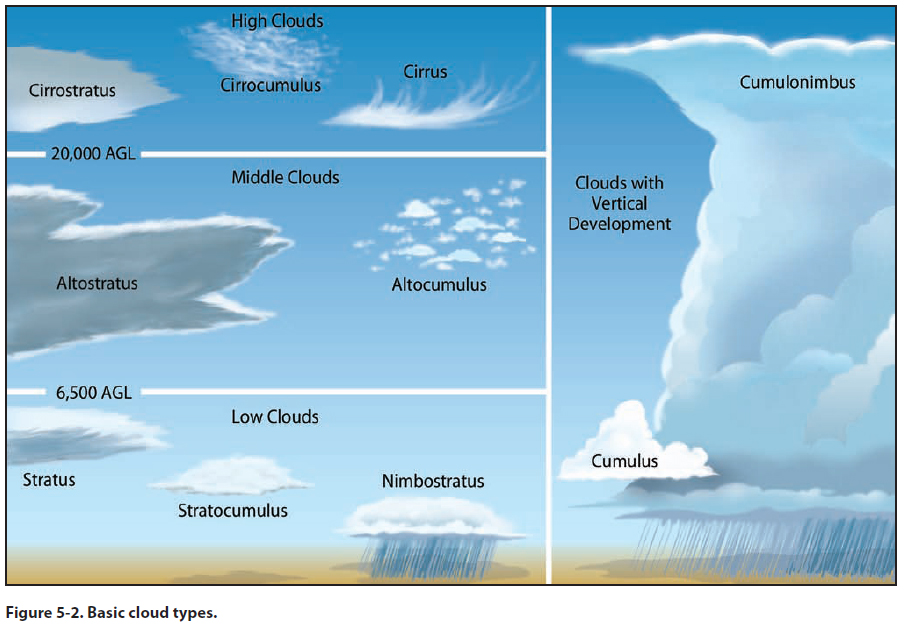|
Chapter 5 ó Preflight and Ground Operations
Weather
The weather is a determining factor for all flight operations.
Get a full weather briefing prior to your flight,
to include the current conditions and forecasts for
your departure and destination areas, and along the
route of flight. There are many sources for obtaining a
weather briefing, such as www.nws.noaa.gov, calling
1-800-WX-BRIEF, and a variety of internet sites that
specialize in local and regional weather. Crosswind
landings are possible in a powered parachute, but
crosswind takeoffs should be avoided. It is important
to review your departure procedure at your destination
to ensure you donít get into a field you cannot
depart from. In gathering your weather information,
know the wind conditions, temperature and dew point
spread, sky condition, and visibility. Review Chapters
10 and 11 in the Pilotís Handbook of Aeronautical
Knowledge for a comprehensive understanding of
weather theory, reports, forecasts, and charts.
PPCs fly best in calm air. Check the wind forecast as
well as current conditions, as this information will determine
whether safe flight can be conducted. Winds
less than 10 miles per hour (MPH) are ideal; follow
the recommendations provided by the PPC manufacturer
for the aircraft you will be flying. Steady winds
that are not gusting are more desirable, as the inflation
and overall performance of the wing is more predictable.
For example, 5 MPH with no gusting is better
than 1 MPH gusting to 5 MPH. Some types of wings
perform differently in certain types of wind conditions
and pilotage skillsó
know your wing and your
abilities. Crosswind takeoffs in a powered parachute
are dangerous and should be avoided. If the runway
configuration does not allow for takeoff into the wind,
then the flight should be canceled or postponed from
that takeoff area. Do not attempt to take off in a crosswind
with a powered parachute unless it is within the
pilot and aircraft capabilities, not a limitation in the
aircraft POH, and you have been trained thoroughly
for this advanced procedure. Crosswind landings are
possible in a powered parachute, but crosswind takeoffs
should be avoided. It is important to review your
departure procedure at your destination to ensure you
donít get into a field you cannot depart from.
Air temperature and humidity directly affect the performance
of the powered parachute wing and engine.
The powered parachute pilot who doesnít understand
and respect the effect(s) density altitude has on any
given flight may get into situations that are not desirable
and could be hazardous. The higher the temperature,
humidity, and the actual altitude of the field
you are operating from, the greater the role density
altitude plays in determining how much runway the
powered parachute needs to get off the ground with
the load on board, and how much climb performance
the wing will have once airborne. The powered parachute
may have cleared that obstacle at 8 a.m. when
the weather conditions were cooler with less humidity,
but at 1 p.m. with increased air temperature and
higher humidity levels the pilot will have to re-evaluate
the performance of that same aircraft. You need a
full understanding of density altitude to be a safe PPC
pilot; refer to Chapter 9 in the Pilotís Handbook of
Aeronautical Knowledge.
Understand the different cloud formations and the
ground/air effects they can produce. [Figure 5-2] Cloud
clearance and visibility should be maintained for the
operations you intend to conduct (see Chapter 8 for
cloud clearance requirements in each class of airspace).
Knowledge of thermals and turbulence, and how to
determine where they can occur is also important.
[Figure 5-3]


Do not fly when ground and flight visibility is below
minimums for your pilot certificate and the class of
airspace where you will be operating (see Chapter 8).
Be particularly watchful for low visibilities when the
air and dewpoint temperatures are within a spread of
three or four degrees. The closer these temperatures
are to each other, the greater the chance for fog and
reduced visibility conditions.
In addition to adhering to the regulations and manufacturer
recommendations for weather conditions, itís
important for you to develop your own set of personal
minimums. These minimums will evolve as you gain
experience, and are also dependent on your recency
and currency in the make/model of aircraft you will
be flying.
Weight and Loading
Weight and loading must be considered before each
flight. Do not exceed the maximum gross weight as
specified in the POH. Always follow the POH performance
limitations.
The balance of the pilot, passenger, fuel and baggage
must be compared to the limitations, and the wing attachment
to the fuselage position must be within the
limits as specified in the POH. The cart must be balanced
properly or an unsafe cart configuration, either
nose-high or nose-low will result.
|

